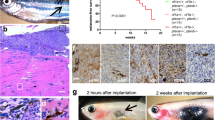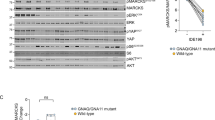Abstract
Stimulation of the c-Kit receptor tyrosine kinase has a critical role in the development and migration of melanocytes, and oncogenic c-Kit mutants contribute to the progression of some melanomas. c-Kit signalling activates the mitogen-activated protein kinase (MAPK) and phosphatidylinositol 3-kinase (PI3K) pathways and their relative contribution to the activities of oncogenic and ligand-dependent c-Kit remains uncertain. We show that PI3K is a major regulator of MAPK activation in response to c-Kit activity and the dominant effector of c-Kit-driven melanocyte proliferation and melanoma survival. Nevertheless, inhibition of the PI3K pathway in c-Kit mutant melanoma cells did not replicate the apoptotic efficacy of the c-Kit inhibitor, imatinib mesylate. Instead, the simultaneous suppression of the PI3K and MAPK pathways promoted a strong synergistic apoptotic effect. These data indicate that MAPK functions as a redundant survival signal that reinforces the PI3K cascade in c-Kit mutant melanoma. Thus, the concurrent inhibition of PI3K and MAPK signalling is required to suppress oncogenic c-Kit activity and may provide an effective therapeutic strategy in c-Kit mutant melanomas.
This is a preview of subscription content, access via your institution
Access options
Subscribe to this journal
Receive 50 print issues and online access
$259.00 per year
only $5.18 per issue
Buy this article
- Purchase on Springer Link
- Instant access to full article PDF
Prices may be subject to local taxes which are calculated during checkout







Similar content being viewed by others
References
Yoshida H, Kunisada T, Grimm T, Nishimura EK, Nishioka E, Nishikawa SI . Review: melanocyte migration and survival controlled by SCF/c-kit expression. J Investig Dermatol Symp Proc 2001; 6: 1–5.
Roskoski R . Signalling by Kit protein-tyrosine kinase--the stem cell factor receptor. Biochem Biophys Res Commun 2005; 337: 1–13.
Heinrich MC, Blanke CD, Druker BJ, Corless CL . Inhibition of KIT tyrosine kinase activity: a novel molecular approach to the treatment of KIT-positive malignancies. J Clin Oncol 2002; 20: 1692–1703.
Antonescu CR, Busam KJ, Francone TD, Wong GC, Guo T, Agaram NP et al. L576P KIT mutation in anal melanomas correlates with KIT protein expression and is sensitive to specific kinase inhibition. Int J Cancer 2007; 121: 257–264.
Curtin JA, Busam K, Pinkel D, Bastian BC . Somatic activation of KIT in distinct subtypes of melanoma. J Clin Oncol 2006; 24: 4340–4346.
Rivera RS, Nagatsuka H, Gunduz M, Cengiz B, Gunduz E, Siar CH et al. C-kit protein expression correlated with activating mutations in KIT gene in oral mucosal melanoma. Virchows Arch 2008; 452: 27–32.
Beadling C, Jacobson-Dunlop E, Hodi FS, Le C, Warrick A, Patterson J et al. KIT gene mutations and copy number in melanoma subtypes. Clin Cancer Res 2008; 14: 6821–6828.
Handolias D, Salemi R, Murray W, Tan A, Liu W, Viros A et al. Mutations in KIT occur at low frequency in melanomas arising from anatomical sites associated with chronic and intermittent sun exposure. Pigment Cell Melanoma Res 2010; 23: 210–215.
Hodi FS, Friedlander P, Corless CL, Heinrich MC, Mac Rae S, Kruse A et al. Major response to imatinib mesylate in KIT-mutated melanoma. J Clin Oncol 2008; 26: 2046–2051.
Lutzky J, Bauer J, Bastian BC . Dose-dependent, complete response to imatinib of a metastatic mucosal melanoma with a K642E KIT mutation. Pigment Cell Melanoma Res 2008; 21: 492–493.
Carvajal RD, Antonescu CR, Wolchok JD, Chapman PB, Roman RA, Teitcher J et al. KIT as a therapeutic target in metastatic melanoma. JAMA 2011; 305: 2327–2334.
Guo J, Si L, Kong Y, Flaherty KT, Xu X, Zhu Y et al. Phase II, open-label, single-arm trial of imatinib mesylate in patients with metastatic melanoma harboring c-Kit mutation or amplification. J Clin Oncol 2011; 29: 2904–2909.
Gounder MM, Maki RG . Molecular basis for primary and secondary tyrosine kinase inhibitor resistance in gastrointestinal stromal tumor. Cancer Chemother Pharmacol 2011; 67 (Suppl 1): S25–S43.
Alexeev V, Yoon K . Distinctive role of the c-Kit receptor tyrosine kinase signalling in mammalian melanocytes. J Invest Dermatol 2006; 126: 1102–1110.
Jeon S, Kim NH, Kim JY, Lee AY . Stem cell factor induces ERM proteins phosphorylation through PI3K activation to mediate melanocyte proliferation and migration. Pigment Cell Melanoma Res 2009; 22: 77–85.
Larribere L, Khaled M, Tartare-Deckert S, Busca R, Luciano F, Bille K et al. PI3K mediates protection against TRAIL-induced apoptosis in primary human melanocytes. Cell Death Differ 2004; 11: 1084–1091.
Smalley KS, Contractor R, Nguyen TK, Xiao M, Edwards R, Muthusamy V et al. Identification of a novel subgroup of melanomas with KIT/cyclin-dependent kinase-4 overexpression. Cancer Res 2008; 68: 5743–5752.
Lefevre G, Glotin AL, Calipel A, Mouriaux F, Tran T, Kherrouche Z et al. Roles of stem cell factor/c-Kit and effects of Glivec/STI571 in human uveal melanoma cell tumorigenesis. J Biol Chem 2004; 279: 31769–31779.
Monsel G, Ortonne N, Bagot M, Bensussan A, Dumaz N . c-Kit mutants require hypoxia-inducible factor 1alpha to transform melanocytes. Oncogene 2010; 29: 227–236.
Kim KB, Lewis K, Pavlick AC, Infante JR, Ribas A, Sosman JA et al(eds). A phase II study of the MEK1/MEK2 inhibitor GSK1120212 in metastatic BRAF-V600E or K mutant cutaneous melanoma patients previously treated with or without a BRAF inhibitor. International Melanoma Congress. Pigment Cell Res, Tampa, Florida, USA, 2011.
Shi H, Kong X, Ribas A, Lo RS . Combinatorial treatments that overcome PDGFRbeta-driven resistance of melanoma cells to V600EB-RAF inhibition. Cancer Res 2011; 71: 5067–5074.
Villanueva J, Vultur A, Lee JT, Somasundaram R, Fukunaga-Kalabis M, Cipolla AK et al. Acquired resistance to BRAF inhibitors mediated by a RAF kinase switch in melanoma can be overcome by cotargeting MEK and IGF-1R/PI3K. Cancer Cell 2010; 18: 683–695.
Kontogianni-Katsarou K, Dimitriadis E, Lariou C, Kairi-Vassilatou E, Pandis N, Kondi-Paphiti A . KIT exon 11 codon 557/558 deletion/insertion mutations define a subset of gastrointestinal stromal tumors with malignant potential. World J Gastroenterol 2008; 14: 1891–1897.
Martin J, Poveda A, Llombart-Bosch A, Ramos R, Lopez-Guerrero JA, Garcia del Muro J et al. Deletions affecting codons 557–558 of the c-KIT gene indicate a poor prognosis in patients with completely resected gastrointestinal stromal tumors: a study by the Spanish Group for Sarcoma Research (GEIS). J Clin Oncol 2005; 23: 6190–6198.
Garrido MC, Bastian BC . KIT as a therapeutic target in melanoma. J Invest Dermatol 2010; 130: 20–27.
Wardelmann E, Neidt I, Bierhoff E, Speidel N, Manegold C, Fischer HP et al. c-kit mutations in gastrointestinal stromal tumors occur preferentially in the spindle rather than in the epithelioid cell variant. Mod Pathol 2002; 15: 125–136.
Woodman SE, Trent JC, Stemke-Hale K, Lazar AJ, Pricl S, Pavan GM et al. Activity of dasatinib against L576P KIT mutant melanoma: molecular, cellular, and clinical correlates. Mol Cancer Ther 2009; 8: 2079–2085.
Liang R, Wallace AR, Schadendorf D, Rubin BP . The phosphatidyl inositol 3-kinase pathway is central to the pathogenesis of Kit-activated melanoma. Pigment Cell Melanoma Res 2011; 24: 714–723.
Larribere L, Hilmi C, Khaled M, Gaggioli C, Bille K, Auberger P et al. The cleavage of microphthalmia-associated transcription factor, MITF, by caspases plays an essential role in melanocyte and melanoma cell apoptosis. Genes Dev 2005; 19: 1980–1985.
Jiang X, Zhou J, Yuen NK, Corless CL, Heinrich MC, Fletcher JA et al. Imatinib targeting of KIT-mutant oncoprotein in melanoma. Clin Cancer Res 2008; 14: 7726–7732.
Omholt K, Grafstrom E, Kanter-Lewensohn L, Hansson J, Ragnarsson-Olding BK . KIT pathway alterations in mucosal melanomas of the vulva and other sites. Clin Cancer Res 2011; 17: 3933–3942.
Aksamitiene E, Kiyatkin A, Kholodenko BN . Cross-talk between mitogenic Ras/MAPK and survival PI3K/Akt pathways: a fine balance. Biochem Soc Trans 2012; 40: 139–146.
Bauer S, Duensing A, Demetri GD, Fletcher JA . KIT oncogenic signalling mechanisms in imatinib-resistant gastrointestinal stromal tumor: PI3-kinase/AKT is a crucial survival pathway. Oncogene 2007; 26: 7560–7568.
Si L, Xu X, Kong Y, Flaherty KT, Chi Z, Cui C et al. Major response to everolimus in melanoma with acquired imatinib resistance. J Clin Oncol 2012; 30: e37–e40.
Nazarian R, Shi H, Wang Q, Kong X, Koya RC, Lee H et al. Melanomas acquire resistance to B-RAF(V600E) inhibition by RTK or N-RAS upregulation. Nature 2010; 468: 973–977.
Atefi M, von Euw E, Attar N, Ng C, Chu C, Guo D et al. Reversing Melanoma Cross-Resistance to BRAF and MEK Inhibitors by Co-Targeting the AKT/mTOR Pathway. PLoS One 2011; 6: e28973.
Gopal YN, Deng W, Woodman SE, Komurov K, Ram P, Smith PD et al. Basal and treatment-induced activation of AKT mediates resistance to cell death by AZD6244 (ARRY-142886) in Braf-mutant human cutaneous melanoma cells. Cancer Res 2010; 70: 8736–8747.
Shimizu T, Tolcher AW, Papadopoulos KP, Beeram M, Rasco DW, Smith LS et al. The clinical effect of the dual-targeting strategy involving PI3K/AKT/mTOR and RAS/MEK/ERK pathways in patients with advanced cancer. Clin Cancer Res 2012; 18: 2316–2325.
Takayama Y, Kokuryo T, Yokoyama Y, Nagino M, Nimura Y, Senga T et al. MEK inhibitor enhances the inhibitory effect of imatinib on pancreatic cancer cell growth. Cancer Lett 2008; 264: 241–249.
Halaban R, Ghosh S, Duray P, Kirkwood JM, Lerner AB . Human melanocytes cultured from nevi and melanomas. J Invest Dermatol 1986; 87: 95–101.
Chou TC, Talalay P . Quantitative analysis of dose-effect relationships: the combined effects of multiple drugs or enzyme inhibitors. Adv Enzyme Regul 1984; 22: 27–55.
Acknowledgements
We are grateful to Antoni Ribas, Peter Hersey and Meenhard Herlyn for providing c-Kit mutant melanoma cells lines. This work is supported by Programme Grant 633004 and project grants of the National Health and Medical Research Council of Australia (NHMRC) and an infrastructure grant to Westmead Millennium Institute by the Health Department of NSW through Sydney West Area Health Service. Westmead Institute for Cancer Research is the recipient of capital grant funding from the Australian Cancer Research Foundation. HR is a recipient of a Cancer Institute New South Wales, Research Fellowship and a NHMRC Senior Research Fellowship. JT is supported by an Australian Postgraduate Award and a Westmead Medical Research Foundation Top-up Award. The support of the Melanoma Foundation of the University of Sydney and colleagues from Melanoma Institute Australia and the Department of Anatomical Pathology at the Royal Prince Alfred Hospital are also gratefully acknowledged.
Author information
Authors and Affiliations
Corresponding author
Ethics declarations
Competing interests
The authors declare no conflict of interest.
Additional information
Supplementary Information accompanies the paper on the Oncogene website
Rights and permissions
About this article
Cite this article
Todd, J., Scurr, L., Becker, T. et al. The MAPK pathway functions as a redundant survival signal that reinforces the PI3K cascade in c-Kit mutant melanoma. Oncogene 33, 236–245 (2014). https://doi.org/10.1038/onc.2012.562
Received:
Revised:
Accepted:
Published:
Issue Date:
DOI: https://doi.org/10.1038/onc.2012.562
Keywords
This article is cited by
-
Primary mucosal melanoma of the larynx: systematic review of the literature and qualitative synthesis
European Archives of Oto-Rhino-Laryngology (2022)
-
Exosome application in tumorigenesis: diagnosis and treatment of melanoma
Medical Oncology (2022)
-
UTRN inhibits melanoma growth by suppressing p38 and JNK/c-Jun signaling pathways
Cancer Cell International (2021)
-
Emergence of CTNNB1 mutation at acquired resistance to KIT inhibitor in metastatic melanoma
Clinical and Translational Oncology (2017)
-
TRPA1–FGFR2 binding event is a regulatory oncogenic driver modulated by miRNA-142-3p
Nature Communications (2017)



